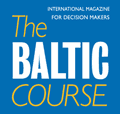
All rights reserved.
You may not copy, reproduce, republish, or otherwise use www.baltic-course.com content
in any way except for your own personal, non-commercial use.
Any other use of content requires the hyperlink to www.baltic-course.com.

Printed: 06.05.2024.
 PrintVilnius light show leads 900 events in european culture capital
PrintVilnius light show leads 900 events in european culture capital
Vilnius gained the status of European capital of culture in 2009, and the first project of almost 900 was launched as the clock struck midnight on Dec. 31, when the centre of the city burst into laser lights and fireworks, as respectable news service Bloomberg/LETA reported.
German artist Gert Hof fired light shows in the Lithuanian capital's Cathedral Square.
June is the climax, with the opening of a museum of contemporary art, concerts of the London Symphony Orchestra led by Russian conductor Valery Gergiev, and the first International Vilnius Opera Festival. Plans are also going ahead for another new museum designed by Pritzker-winning architect Zaha Hadid.
"This is a chance to put Vilnius back on the map of Europe, as well as the world," Arturas Zuokas, Vilnius mayor from 2000 to 2007, said 'figuratively in an interview.
The city of about 550,000 people shares the Capital of Culture title with Austrias Linz.
Other events under the project include Street Musician Day on May 2, covering everything from rock to classical. In early July, the Millennium Song Festival of local music marks 1,000 years since Lithuania was first mentioned as a state.
As mayor, Zuokas pushed to restore Vilnius's 17th-century old town dominated by Baroque churches, and fostered the growth of a modern financial center. Now, being a a Parliament member from the Liberal and Center Party, he said the budget for the year's cultural events has dropped almost 25% from initial 17 million euros, to 13 million euros ($18.1 million).
"There will be some difficulties to manage the full line-up of events, but we intend to do the maximum possible," said Zuokas, who sits on the Capital of Culture steering committee.
On June 19, the Lithuanian Art Museum opens a branch for contemporary art in a building that once housed a museum about the Bolshevik Revolution.
"Contemporary art has yet to be accepted by the Lithuanian public, which still has strong bonds to traditional culture," said Lolita Jablonskiene, the museum's chief curator. "In 2009, the first generation of people who never knew the USSR will turn 18. Young audiences are usually eager to see contemporary art."
Zuokas is pushing ahead with the design and construction of another museum of contemporary art that may be run jointly with the State Hermitage Museum and Solomon R. Guggenheim Foundation.
In April 2008, Hadid won a competition to design the building. Zuokas said he hopes the Hermitage and Guggenheim will play leading roles. Neither museum has committed, and both are expected to make decisions on participation in the next several months, he said.